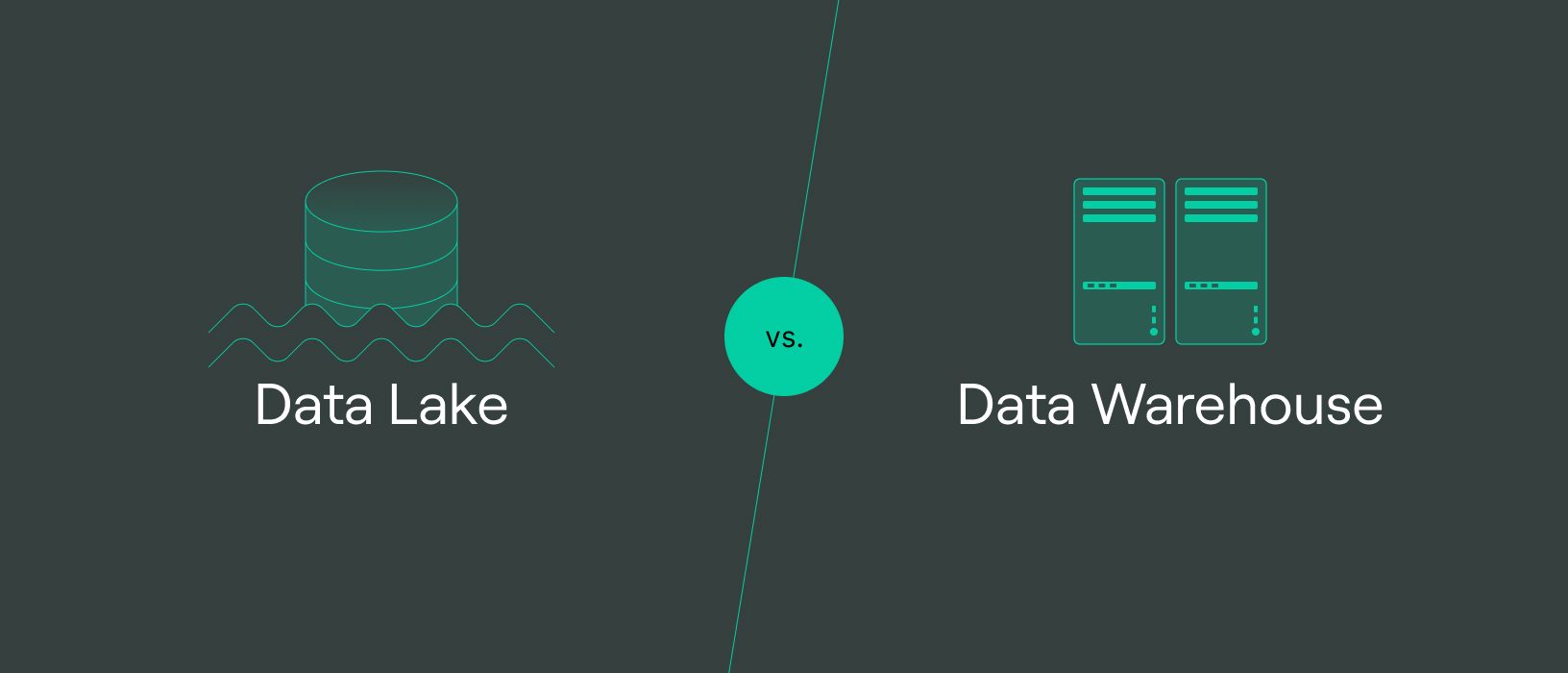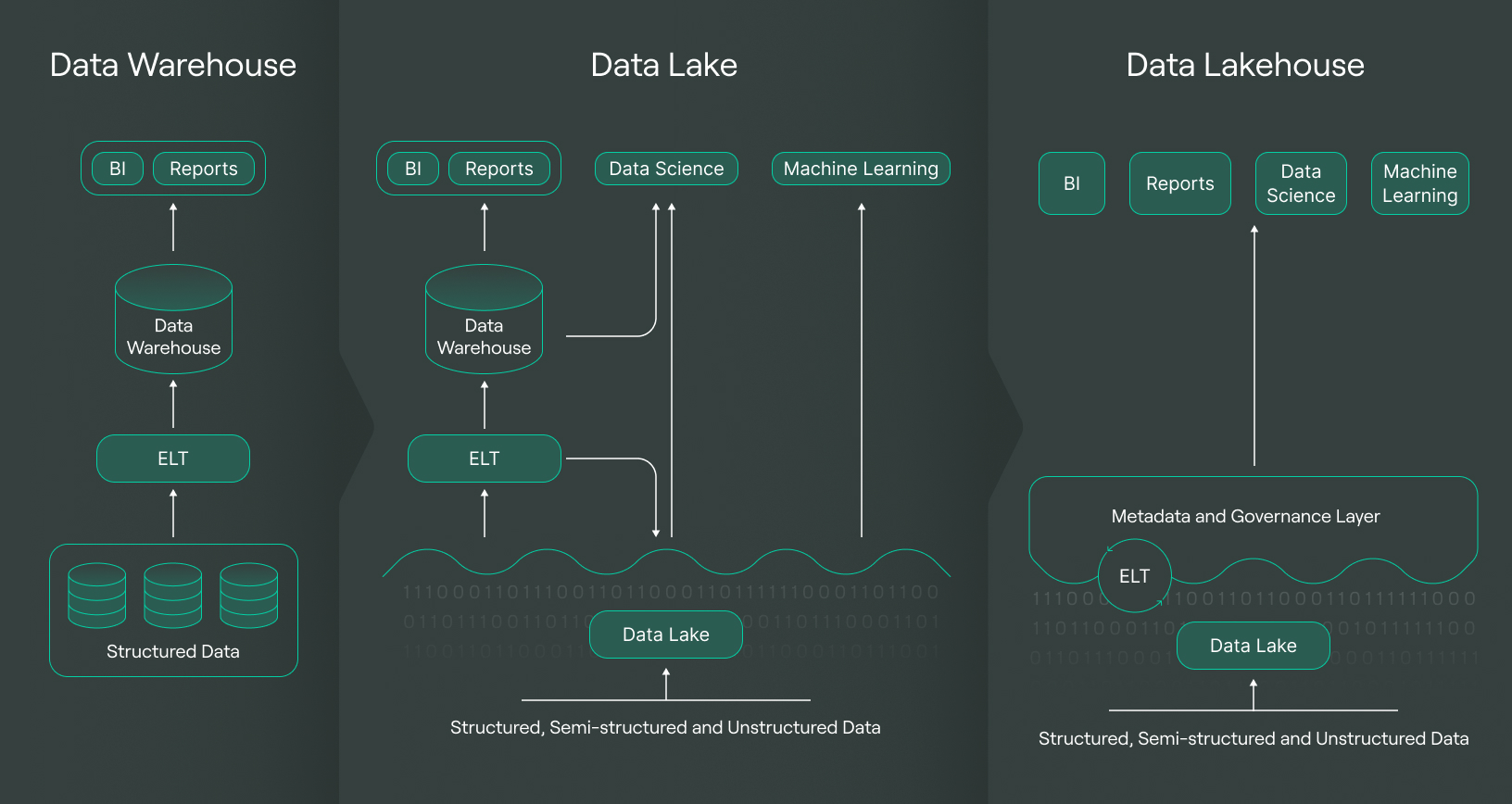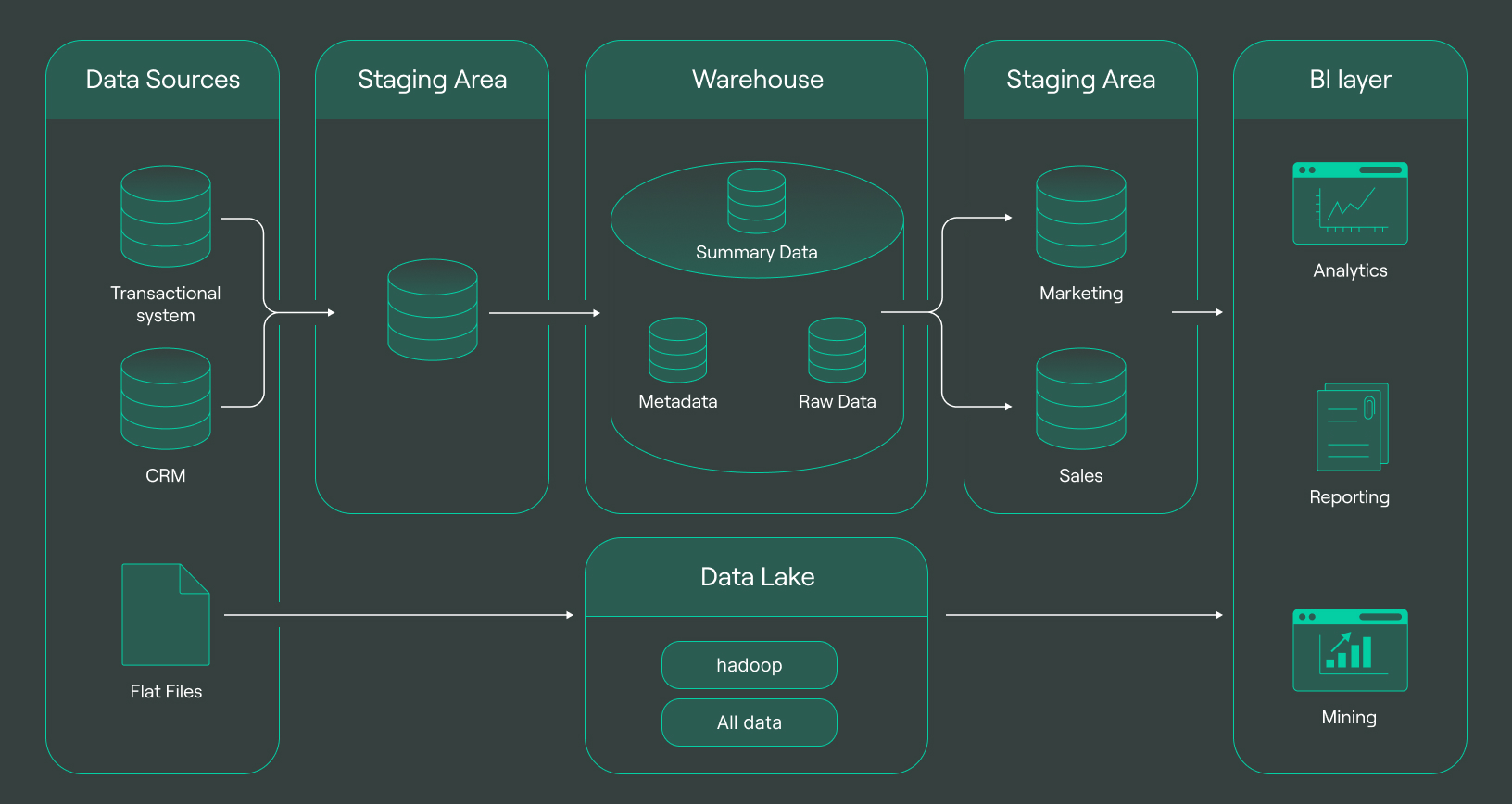
Data mart or data lake: Choosing the right solution
In today’s data-driven world, businesses have access to an abundance of data generated from various sources such as transactional systems, web server logs, sensor data, and external data sources. To make informed decisions, organizations need to process, store, and analyze this data. This is where data warehouses come into play.
Data warehouses typically store detailed data in a structured format, making it easy for business users to access and analyze data. However, with the rise of big data and unstructured data, data lakes have become an alternative solution for storing all the data in its raw form.
In this article, we’ll explore the key difference between data lake vs data mart and help you choose the right solution for your business function.

In this article, we’ll talk about:
- What is data lake?
- What is data mart?
- Why is it important to know the difference between data lake and data mart?
- Key differences between data lakes and data marts everyone should know of
- Data mart vs. data lake: side-by-side comparison
- Are there any similarities between them?
- What are the pros and cons of data lake
- What are the pros and cons of data mart
- Data lake vs data mart vs data warehouse
- Choosing the right data management solution for your business
- Final words
What is data lake?
A data lake is a storage repository that stores data in its raw format, without any predefined structure or schema. Here are some of the key characteristics, architecture, and components of a data lake:
Characteristics:
-
Stores all types of data, including structured, semi-structured, and unstructured data
-
Designed to be highly scalable and cost-effective
-
Supports various data sources, both internal and external
-
Offers fast and easy data access for analysis and processing
-
Provides a flexible schema-on-read approach for data querying and analysis
Architecture:
-
Data lake architecture is based on a distributed file system, such as Hadoop Distributed File System (HDFS), Amazon Simple Storage Service (S3), or Azure data lake Storage (ADLS).
-
Data lakes are built on top of cloud-based infrastructure and use cloud-based storage solutions, making them highly scalable and cost-effective.
-
The architecture also includes data ingestion tools that can handle different data formats and sources, data processing tools for cleaning, transforming, and enriching data, and data analytics tools for querying and analyzing data.
Components:
-
Data ingestion tools enable the ingestion of data from various sources, including batch processing and real-time streaming data.
-
Data processing tools are used to clean, transform, and enrich data for analysis and querying.
-
Data storage is the central component of the data lake architecture, and it stores all data in its raw format.
-
Data analytics tools enable users to query and analyze data using various tools, including SQL queries and machine learning algorithms.
-
Data governance tools provide visibility and control over data access, quality, and security.
What is data mart?
A data mart is a subset of an enterprise’s data warehouse, which stores business data from a specific business unit or department. Its primary function is to provide fast and easy access to data for business users, analysts, and data scientists. Unlike data lakes, marts are built on a relational database, and their structure is optimized for the specific needs of the business function they serve.
The components of a data mart include data sources, extract-transform-load (ETL) processes, data storage, and access tools. Data marts only hold summarized data, with less emphasis on storing raw data or integrating data from external sources. Dependent data marts rely on an existing data warehouse, while independent data marts can stand alone.
The architecture of a data mart is different from a data warehouse. It is built as an independent data repository that is tailored to meet the specific needs of a business unit.
Read more about data mart and their use cases — What is a Data Mart? Key Concepts and Advantages
Why is it important to know the difference between data lake and data mart?
Ignoring the key differences between a data lake and a data mart can lead to serious consequences for a business. For instance, if a business fails to differentiate between the two and uses them interchangeably, it can affect the quality and consistency of the data. Raw data, which is typically stored in a data lake, can become polluted with inaccurate or irrelevant data, affecting data analysis and insights.
Note that data marts store structured data that has already been processed for specific business purposes. They also provide enhanced data analytics and insights by storing summarized and processed data sets that can be accessed quickly and easily by business users.
Understanding the key difference between a data lake and a mart is crucial for improved data quality and consistency. Data Scientists and data engineers can leverage data lakes to store raw data from different data sources, process data, and perform data integration. This data can then be analyzed to reveal insights and patterns that inform business decisions.
In terms of operational efficiency and cost savings, data lakes and marts serve different purposes. Data lakes, for example, are ideal for storing and processing large volumes of raw data, while the latter is designed to store specific sets of data for particular business functions. By utilizing the right technology, such as a cloud-based Data Warehouse, businesses can take advantage of both approaches, reducing operational costs and improving efficiency.
Key differences between data lakes and data marts everyone should know of

-
Architecture: A Data lake is a centralized repository that stores all types of data, including raw and unstructured data, in their native format. In contrast, Marts are subsets of a larger Data Warehouse that is designed to store specific data sets for a specific business unit or department.
-
Data sources: Data lakes can collect data from multiple sources, both internal and external, making it ideal for organizations that work with large volumes of unstructured or semi-structured data, such as social media or web server logs. While Marts typically only draw data from internal sources, such as transactional systems, ERP or CRM systems, or marketing databases.
-
Data analytics: Data lakes are designed to support data scientists and other advanced users who need access to the most granular data available. Data marts, on the other hand, are optimized for business intelligence and reporting purposes and typically store summarized business data.
-
Data processing: In a Data lake, data is stored in its raw form, which requires significant processing before it can be used for analytics or other purposes. In contrast, Marts store processed data that has already been transformed, cleaned, and organized for a specific business function or purpose.
-
Scalability: Data lakes are highly scalable and can store large volumes of data with ease, while data mart are typically designed for smaller, department-level data sets. Additionally, data lakes can support both structured and unstructured data types, but Marts are limited to structured data only.
Data mart vs. data lake: side-by-side comparison
|
Characteristic |
Data mart |
Data lake |
|
Definition |
A subset of a larger data warehouse, which contains data specific to a particular business function or group |
A centralized repository that stores raw data in its native format, without predefining how it will be used |
|
Purpose |
To provide access to processed data for business intelligence and analytics |
To store all types of data, including structured, semi-structured, and unstructured data, for future analysis and machine learning |
|
Data Structure |
Typically structured and summarized data, tailored to specific business units or functions |
All types of data, including raw, semi-structured, and unstructured data |
|
Data Processing |
Data is pre-aggregated and pre-processed, making it easier and faster to analyze |
Data is not pre-processed, and can be processed in any way required for future analysis |
|
Data Access |
Limited to pre-defined business functions and users |
Accessible to all business units and users with appropriate permissions |
|
Data Quality |
Generally high, with a focus on accuracy and completeness |
Can be varied and less reliable, as raw data is stored without pre-processing |
|
Cost |
Can be expensive to set up and maintain, as each data mart requires its own infrastructure and management |
Can be more cost-effective, as data is stored in a single repository without predefined schema or data structure |
|
Security |
Usually more secure, as access is limited to specific business units or functions |
Requires strong security measures to protect sensitive and confidential data |
|
Skillset |
Data engineers and business users with data warehousing and data integration expertise |
Data engineers and data scientists with machine learning and big data expertise |
|
Use Cases |
Suitable for specific business functions or units with defined data needs, such as marketing, finance, and HR |
Suitable for organizations that want to store all types of data for future analysis, such as web server logs, sensor data, and external data sources |
Are there any similarities between them?
Large amounts of data can be stored and managed using these two data storage architectures known as data mart and Lake. Both of them can be used to manage and store structured and unstructured data, which is useful for many applications in business intelligence and data analytics.
To choose the best architecture for the unique use case in your organization, you must first understand the more significant differences and similarities between the two. A data lake is intended for broader use and can support a variety of analytics and machine learning applications, whereas Marts are best suited for department-level analysis and concentrates on particular business functions or units.
What are the pros and cons of data lake
Pros
-
Scalability: Data lakes are highly scalable and can store large volumes of data of varying types and structures.
-
Flexibility: Data lakes can store raw data without the need for predefined schemas or data models, making it easier to adapt to changing business needs.
-
Cost-effectiveness: Data lakes can be built using cost-effective cloud-based storage solutions, reducing the need for expensive on-premises hardware and maintenance.
-
Accessibility: Data lakes allow easy access to data for different teams within an organization, making it easier to collaborate on projects and share insights.
-
Real-time processing: Data lakes can support real-time data processing, enabling organizations to make informed decisions quickly based on the most up-to-date data.
Cons
-
Lack of structure: Data lakes store raw, semi-structured and unstructured data, which can be challenging to analyze, leading to difficulty in extracting insights from data.
-
Security concerns: Data lakes can be vulnerable to security threats, including unauthorized access, data breaches, and cyber-attacks.
-
Data governance: The large volume of data stored in data lakes can make it challenging to manage and govern the data by data engineers effectively.
-
Complexity: Implementing a data lake can be a complex process, requiring significant resources, expertise, and investment. Additionally, integrating data from multiple sources can be a time-consuming and challenging process. Also, extracting data from a data lake is quite a challenging task.
-
Lack of standardization: Since data lakes store all types of data, including raw and unstructured data, there may be a lack of standardization in terms of data format, metadata, and data definitions.
What are the pros and cons of data mart
Pros
-
Quick and easy access to specific data: Marts provide a way to quickly access and analyze specific data related to a specific business function or department.
-
Improved data quality: Data marts can improve data quality by focusing on a specific set of data and ensuring that it is consistent and accurate.
-
Reduced costs: Marts can be less expensive than building a full-scale enterprise data warehouse.
-
Increased performance: Data marts can provide faster query response times and improved * performance compared to querying a large, centralized data warehouse.
-
Flexibility and scalability: Marts can be designed to be flexible and scalable, allowing for easy expansion as the needs of the business change over time.
-
Improved security: Data marts can be designed to provide enhanced security and access controls, limiting access to sensitive data to only those who need it.
Cons
-
Limited scope: Data marts are designed to serve a specific business unit, which means they have a limited scope and can only provide insights into a particular area of the organization.
-
Data redundancy: They are designed for specific purposes and often contain redundant data that may already exist in other data marts or in the enterprise data warehouse
-
Cost: Creating and maintaining data marts can be expensive, especially if there are multiple data marts that need to be integrated.
-
Maintenance: Data marts require ongoing maintenance, which can be time-consuming and costly.
-
Dependent on the data warehouse: Data marts are dependent on the data warehouse for their data sources.
-
Limited historical data: Data marts typically only store a limited amount of historical data, which can make it difficult to analyze trends and patterns over time, for instance, using data science technology.
Data lake vs data mart vs data warehouse

Now let’s sum it up and compare data warehouse, data lake and data mart all in one table for your convenience
You can read more about difference between data lake and data warehouse in our article — Data Lakes vs. Data Warehouses: A Deep Dive into Understanding the Key Differences
|
Data lake |
Data warehouse |
Data mart |
|
Designed to store all types of data, structured, semi-structured, or unstructured, at any scale |
Typically used for structured data, organized in a schema |
Subset of a data warehouse, designed to serve a specific business function or department |
|
Stores data in its native/raw format, before processing or structuring |
Stores processed and structured data |
Contains summarized and aggregated data |
|
Can handle data from various sources, including internal and external data sources, web server logs, and sensor data |
Data is sourced from internal transactional systems |
Contains data from a specific department, business function or specific business unit |
|
Enables data scientists and analysts to process and analyze data in a variety of ways, including machine learning and data analytics |
Primarily used for business intelligence and data analysis |
Used for more targeted and specific analysis, such as preparing customer account statements |
|
Built on a distributed architecture, using cloud-based data warehousing solutions |
Typically relies on relational databases, stored in on-premise servers |
Can be dependent or independent, depending on whether it draws from a larger data warehouse or operates independently |
|
Primarily focuses on storing raw data, and provides flexibility in terms of data processing and analysis |
Mainly focuses on storing detailed data and providing fast access to information |
Contains summarized and aggregated data, with a focus on specific business processes or functions |
|
Serves as a centralized repository for all data, including structured, semi-structured, and unstructured data |
Designed to store large amounts of data for historical analysis |
Contains data that is relevant to specific business operations or processes |
Choosing the right data management solution for your business
Although data lakes store all data types, including raw data, in a single repository, data marts are typically created to serve a particular business unit or function. This means lakes are better suited for businesses looking to store and analyze large amounts of unstructured data, whereas data marts are better suited for structured data and specific use cases.
Secondly, if your business needs involve real-time processing and analytics then data lakes is the better option. On the other hand, data marts are frequently used for historical data analysis. Also, compared to data lakes, marts are typically smaller in size, quicker to set up, and simpler to maintain.
However, the availability of data sources and the knowledge of data scientists and analysts may influence the decision between a data mart and lake.
Final words
In conclusion, choosing between a data lake and a data mart depends on the specific needs of your business. Understanding the difference between a data warehouse, a data lake, and a data mart is crucial to making an informed decision. While a data warehouse stores structured data for business intelligence purposes, a data lake stores all types of raw and unstructured data for data analytics and machine learning.
On the other hand, a data mart is a subset of a data warehouse that focuses on specific business functions or departments. Consider factors such as data sources, data types, data storage, data processing, and data access when deciding which solution is right for your business. By making an informed decision, you can effectively use data to drive business growth and success.
Frequently asked questions (FAQ)
What is the difference between data warehouse and data lake?
What is the difference between data warehouse and data lake?
A data warehouse is a central location for structured, processed data that is intended for reporting and business intelligence. On the other hand, a data lake is a distributed storage system that enables advanced analytics and machine learning by storing structured, semi-structured, and unstructured data in its raw form.
What are the main differences between data mart and data lake?
What are the main differences between data mart and data lake?
What are common use cases for data mart and data lake?
What are common use cases for data mart and data lake?
How can I benefit from using Data Lake or data mart?
How can I benefit from using Data Lake or data mart?
Get started for free



